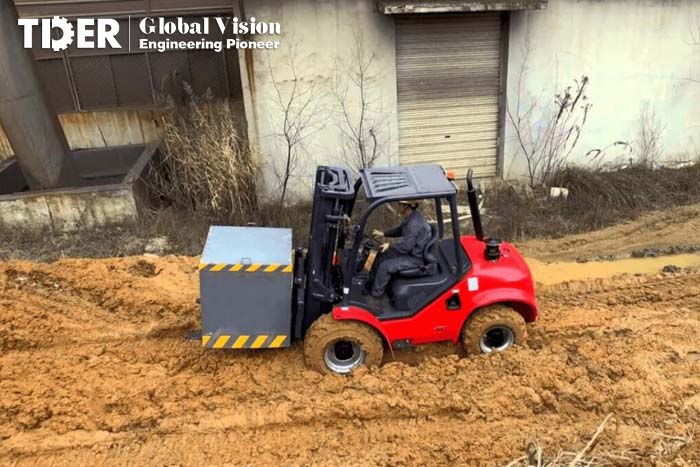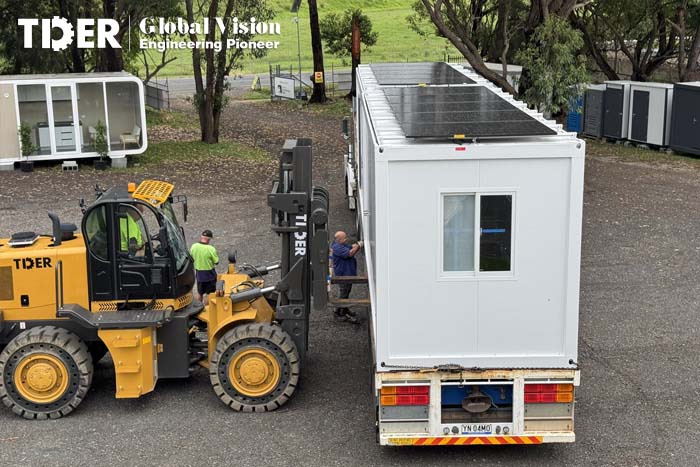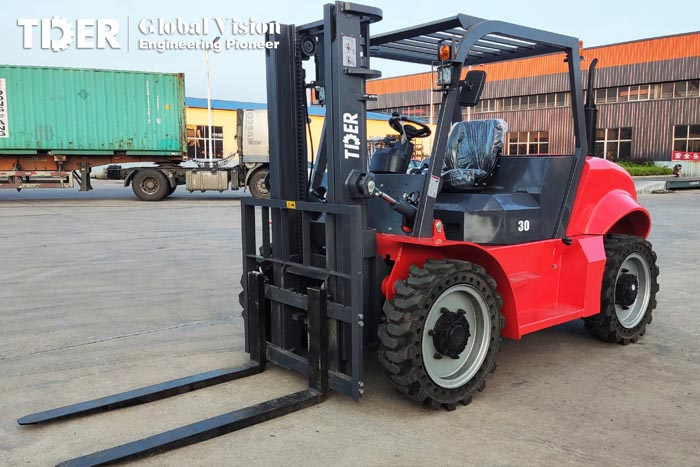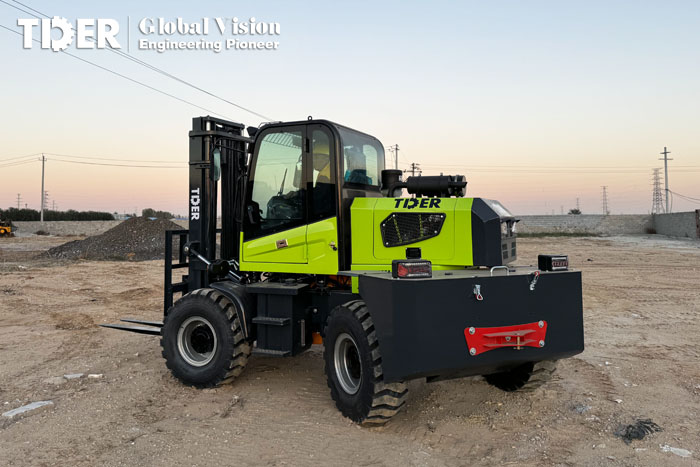Service Hotline:86-0592-5681408 / 86-17346269651
In unpaved terrains such as construction sites, forests, mines, and farms, standard industrial forklifts often fall short. Rough terrain forklifts (Rough Terrain Forklifts), with their superior off-road capability and robust performance, have become indispensable in these challenging scenarios. Among Rough Terrain Forklift models, two major structural categories dominate the market: Rigid (integrated-frame) rough terrain forklift and articulated rough terrain forklift.
For buyers or fleet managers, one key question often arises: Which is better—Rigid or articulated rough terrain forklifts?
This report from TDER provides an in-depth comparison of their structural differences, performance features, cost considerations, and application scenarios to help buyers choose the most suitable solution for their needs.
I. What Is a Rigid Rough Terrain Forklift?
A Rigid rough terrain forklift is designed with a rigid, integrated steel frame (Rigid frame), specifically engineered to handle uneven surfaces, unpaved conditions, and moderately harsh environments. Unlike conventional forklifts, it has no articulated joints between the front and rear chassis. The one-piece structure offers high structural strength, balanced load distribution, and operational stability.
Rigid Rough Terrain Forklifts typically come with upgraded powertrains, large-diameter off-road tires, high ground clearance, and heavy-duty axles. They are often equipped with four-wheel drive systems and high-performance diesel engines, enabling them to handle demanding environments such as job sites, rural roads, storage yards, and brick factories. Most models feature front- or rear-wheel steering, while some premium units include four-wheel steering for improved agility.
Key Structural and Performance Features:
1. Rigid One-Piece Frame for Greater Stability
The chassis is manufactured using high-strength steel plates and one-time welding processes, eliminating stress concentrations at joints. This improves torsional rigidity and load capacity, ensuring long-term structural stability even under heavy or continuous loads.
2. Familiar Operation for Easier Training
Operators accustomed to standard industrial forklifts will find Rigid Rough Terrain Forklifts intuitive, requiring minimal additional training. This saves time and labor costs, especially in hybrid indoor-outdoor operations.
3. High Ground Clearance for Enhanced Terrain Capability
With a typical ground clearance above 300mm, these machines avoid bottoming out and can easily handle gravel, mud, roadside ditches, and unpaved routes. Wide tire options with aggressive tread patterns further enhance traction.
4. Lower Center of Gravity for Improved Safety
Thanks to the concentrated chassis weight and non-swinging frame, Rigid forklifts offer greater safety during high-lift, heavy-load operations—particularly in industries handling materials like concrete components, bricks, lumber, and panels.
5. Attachment Compatibility for Versatile Operations
Rigid models support a wide range of attachments such as forks, clamps, booms, and push-pull devices. This versatility makes them ideal for industries like timber, stone handling, and livestock farming.

II. What Is an Articulated Rough Terrain Forklift?
An articulated Rough Terrain Forklift is built around a two-part chassis connected by a central pivot (articulation). Steering is achieved by hydraulically swinging the front and rear frames, similar to wheel loaders or articulated dump trucks.
This structure provides outstanding maneuverability and terrain adaptability, especially in confined or rugged environments. The articulated design allows the machine to absorb ground irregularities through frame oscillation, making it highly suitable for off-road operations.
Key Structural and Performance Features:
1. Articulated Steering for Maximum Agility
Unlike front- or rear-wheel steering, articulated models steer by rotating the whole chassis around the central pivot. This reduces turning radius significantly, making them ideal for narrow passages, trails, and mountain roads.
2. Independent Frame Oscillation for Terrain Adaptability
The front and rear frames can move independently over uneven surfaces, enhancing tire-to-ground contact. This improves traction, driving stability, and reduces the risk of wheel lift, slipping, or tipping.
3. Lightweight and Compact for Better Off-Road Performance
While maintaining structural strength, articulated forklifts are lighter and more compact, improving acceleration and terrain clearance. Most models feature full-time 4WD and off-road tires, enabling superior slope-climbing and mud-exit performance.
4. Elevated Operator View and Responsive Handling
The cab is typically mounted mid-to-high on the front frame, offering excellent visibility. Hydraulic steering systems with electronic feedback enable precise control, especially in tight or fast-paced operations.
5. Cost-Effective and High Value
Articulated models are easier to modularize during manufacturing and often share components, reducing production and maintenance costs. They are a popular choice for small-to-medium businesses, temporary job sites, and equipment rental services.

III. Structural Differences & Performance Comparison
Comparison Dimension | Rigid Rough Terrain Forklift | Articulated Rough Terrain Forklift |
Frame Structure | Rigid integrated frame | Front and rear frames connected via articulation |
Steering Method | Mostly front-wheel steering | Steering via articulated pivot |
Stability | High-speed and heavy-load stability | Better low-speed off-road stability |
Off-Road Capability | Moderate; suitable for typical unpaved terrain | Excellent; ideal for extreme conditions |
Turning Radius | Relatively larger | Small; superior maneuverability |
Operator Familiarity | Similar to standard forklift; easy to operate | Similar to loaders; requires adaptation |
Maintenance Complexity | Simple structure; easy to maintain | Requires regular lubrication at articulation |
FOB Price (China) | Typically USD 12,000–18,000 | Typically USD 6,000–8,000 |
Summary:
Rigid rough terrain forklifts are better suited for buyers prioritizing structural strength, safety, and ease of operation. Although the initial purchase cost is higher, the longer lifespan, lower failure rate, and higher residual value make them cost-effective in the long run.
On the other hand, articulated models are more appropriate for users focused on short-term budget control, frequent low-speed operations, or extremely rugged working conditions.
IV. Application Scenarios Comparison
Application Scenario | Recommended Type | Reasoning |
Mines, forests, mountainous job sites | Articulated Rough Terrain Forklift | Handles rough terrain with steep slopes, mud, and rocks; small turning radius suits narrow paths. |
Large-scale construction sites | Rigid Rough Terrain Forklift | High-frequency, heavy-load operations require durability and longevity. |
Rural transport, orchards, farms | Articulated Rough Terrain Forklift | Lightweight loads on unpaved but moderate terrain; cost-effective and agile. |
Ports, logistic parks, brickyards | Rigid Rough Terrain Forklift | Often paved or semi-paved surfaces; needs speed and efficiency. |
Hydropower & wind power bases | Depends on site conditions | Choose Rigid for long transfers or high lifts; articulated for uneven access roads. |
Emergency relief & supply transfer | Articulated Rough Terrain Forklift | Quick deployment, lightweight, and easy to transport. |
V. TDER’s Top Picks: Rough Terrain Forklifts Built for Real-World Demands
At TDER, product development is guided by real user scenarios. Both Rigid and articulated models are engineered for stability, efficiency, and reliability across construction, logistics, agriculture, and more.
Rigid Model Recommendation: TDER RTD30-4WD
1. Full-time 4WD + Rear Axle Differential Lock
Enhances off-road traction and escape performance in mud, gravel, or soft terrain.
2. High Ground Clearance + Off-Road Tires
Elevated chassis and large off-road tires ensure smooth travel over obstacles and rough ground.
3. Wide-View Mast for Safer, More Efficient Stacking
Improves driver visibility, ideal for frequent loading/unloading of pallets, bricks, and construction materials.
4. Smart LCD Display + CAN Bus Technology
Monitors machine status in real time with clear alerts and diagnostics for better management.

Articulated Model Recommendation: TDER TDR30
1. Rear-Wheel Steering + Articulated Chassis
Extremely agile, perfect for orchards, narrow roads, and small job sites with frequent turning needs.
2. Full-Time 4WD + High Chassis Design
Easily overcomes sand, gravel, and shallow ditches; excels in challenging terrain.
3. Triple Cooling System
Separate cooling for engine, transmission, and hydraulics ensures consistent performance in hot, heavy-duty conditions.
4. Reinforced 30mm Steel Bottom Frame
Exceptional shock resistance and durability for continuous heavy-load operations.

In choosing between Rigid and articulated rough terrain forklifts, there’s no absolute “better”—only what suits your working conditions, budget, and operation style. As one of China’s leading rough terrain forklift manufacturers, TDER provides tailored solutions across tonnage, structure, and configuration to help global users conquer every terrain challenge.
If you're unsure which model is right for you, contact us anytime for free site evaluation and expert recommendations. You can also request product brochures or live working videos to explore more.